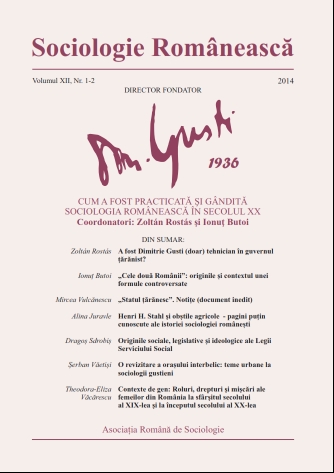„Cele două Românii”: originile şi contextul unei formule controversate
“The Two Romanias”: the Origins and the Context of a Controversial Formula
Author(s): Ionuţ ButoiSubject(s): Social Sciences
Published by: Institutul de cercetare a Calității Vieții (ICCV)
Keywords: Mircea Vulcănescu; interwar history; total history; nationalism; peasant state; monographist
Summary/Abstract: Mircea Vulcănescu’s second contribution to the journal Dreapta [The Right], published in December 1932, became famous by virtue of its syntagmatic title: “The Two Romanias”. Its theme is typical for interwar Romanian society and indicates one of the main preoccupations of the Gustian monographists, namely the multidimensional urban‑rural divide. However, Vulcănescu’s article continues to generate controversy and remains prone to erroneous readings. The analysis recently advanced by Lucian Boia in Capcanele istoriei. Elita intelectuală românească între 1930 şi 1950 [The Pitfalls of History. The Romanian Intellectual Elite Between 1930 and 1950] illustrates the hazards inherent in reading this text through the prism of conventional ideological typologies. Boia interprets Vulcănescu’s article as a symptom of a socially widespread “nationalist psychosis”. This way of asserting the problem is indicative of a pervasive hegemonic framework that structures perceptions and interpretations of interwar Romania. The dominant interpretation frames the social and intellectual cleavages of the interbellic period in terms of a modernization – backwardness” or “democracy – traditionalism/nationalism/orthodoxism” binary. I propose instead a different approach, one that eschews polemics and ideological explanations. My focus is on questions of method. Consequently, I will first provide a detailed critique of the ways Boia contextualizes Vulcănescu’s text. I will then demonstrate the heuristic advantages of scaling down the historical analysis onto the “micro” level. Thus, I will apply a method drawn from the repertoire of social history: the teniques of “total history”. This procedure yields a very different image of interwar intellectual debates and of their substantive stakes for the social actor involved.
Journal: Sociologie Românească
- Issue Year: 12/2014
- Issue No: 01+02
- Page Range: 18-31
- Page Count: 14
- Language: Romanian

